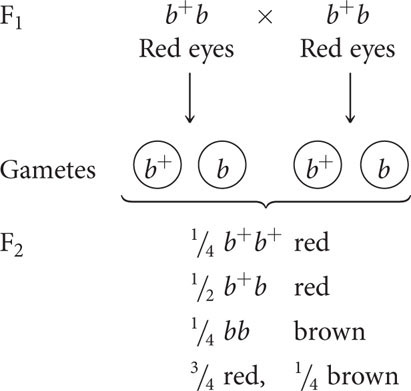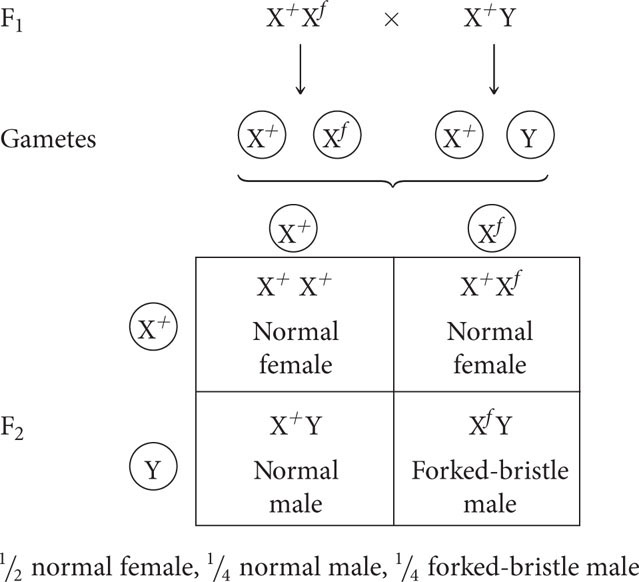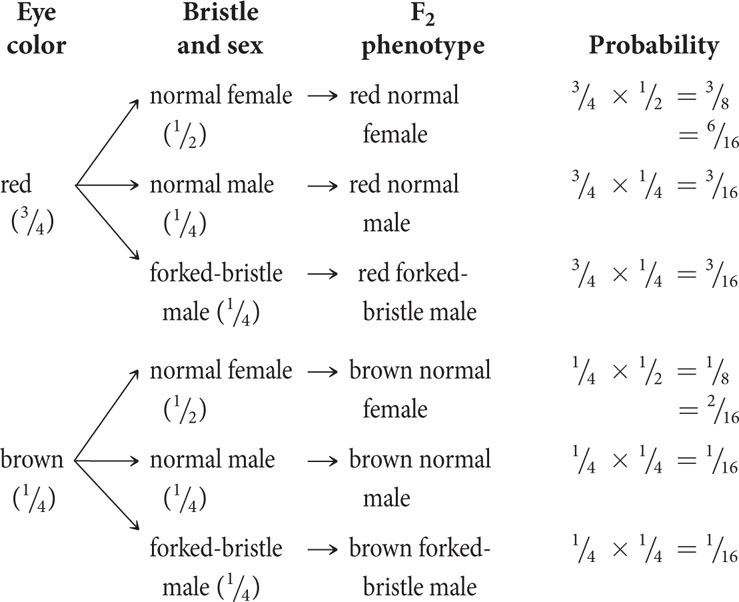Answers to Concept Checks
- 1. Meiosis
- 2. b
- 3. In chromosomal sex determination, males and females have chromosomes that are distinguishable. In genic sex determination, sex is determined by genes, but the chromosomes of males and females are indistinguishable. In environmental sex determination, sex is determined fully or in part by environmental effects.
- 4. a
- 5. c
- 6. All male offspring will have hemophilia, and all female offspring will not have hemophilia so the overall probability of hemophilia in the offspring is
 .
. - 7. Eight large palindromes that allow crossing over within the Y chromosome.
- 8. Two Barr bodies.
WORKED PROBLEMS
A fruit fly has XXXYY sex chromosomes; all the autosomal chromosomes are normal. What sexual phenotype does this fly have?
What information is required in your answer to the problem?
The sexual phenotype of a fly with sex chromosomes XXXYY.
What information is provided to solve the problem?
 The fly has sex chromosomes XXXYY.
The fly has sex chromosomes XXXYY. All autosomal chromosomes are normal.
All autosomal chromosomes are normal.
For help with this problem, review:
Sex determination in Drosophila melanogaster in Section 4.1.
Solution Steps
Sex in fruit flies is predicted by the X : A ratio—the ratio of the number of X chromosomes to the number of haploid autosomal sets. An X : A ratio of 1.0 produces a female fly; an X : A ratio of 0.5 produces a male. If the X : A ratio is greater than 1.0, the fly is a metafemale; if it is less than 0.5, the fly is a metamale; if the X : A ratio is between 1.0 and 0.5, the fly is an intersex.
This fly has three X chromosomes and normal autosomes, so the X : A ratio in this case is  , or 1.5. Thus, this fly is a metafemale.
, or 1.5. Thus, this fly is a metafemale.
Recall: Drosophila melanogaster normally has two sets of autosomes.
In Drosophila melanogaster, forked bristles are caused by an allele (Xf) that is X linked and recessive to an allele for normal bristles (X+). Brown eyes are caused by an allele (b) that is autosomal and recessive to an allele for red eyes (b+). A female fly that is homozygous for normal bristles and red eyes mates with a male fly that has forked bristles and brown eyes. The F1 are intercrossed to produce the F2. What will the phenotypes and proportions of the F2 flies be from this cross?
Solution Strategy
What information is required in your answer to the problem?
Phenotypes and proportions of the F2 flies.
What information is provided to solve the problem?
 Forked bristles are X-linked recessive.
Forked bristles are X-linked recessive. Brown eyes are autosomal recessive.
Brown eyes are autosomal recessive. Phenotypes of the parents of the cross.
Phenotypes of the parents of the cross. The F1 are intercrossed to produce the F2.
The F1 are intercrossed to produce the F2.
For help with this problem, review:
X-linked Color Blindness in Humans in Section 4.2 Section 3.3 in Chapter 3.
Solution Steps
This problem is best worked by breaking the cross down into two separate crosses, one for the X-linked genes that determine the type of bristles and one for the autosomal genes that determine eye color.
Hint: For problems involving multiple loci, break the cross down into two separate crosses.
Let’s begin with the autosomal characteristics. A female fly that is homozygous for red eyes (b+b+) is crossed with a male with brown eyes. Because brown eyes are recessive, the male fly must be homozygous for the brown-eye allele (bb). All of the offspring of this cross will be heterozygous (b+b) and will have red eyes:

The F1 are then intercrossed to produce the F2. Whenever two individual organisms heterozygous for an autosomal recessive characteristic are crossed,  of the offspring will have the dominant trait and
of the offspring will have the dominant trait and  will have the recessive trait; thus,
will have the recessive trait; thus,  of the F2 flies will have red eyes and
of the F2 flies will have red eyes and  will have brown eyes:
will have brown eyes:

Next, we work out the results for the X-linked characteristic. A female that is homozygous for normal bristles (X+ X+) is crossed with a male that has forked bristles (XfY). The female F1 from this cross are heterozygous (X+Xf), receiving an X chromosome with a normal-bristle allele (X+) from their mother and an X chromosome with a forked-bristle allele (Xf) from their father. The male F1 are hemizygous (X+ Y), receiving an X chromosome with a normal-bristle allele (X+) from their mother and a Y chromosome from their father:

Recall: Females have two X-linked alleles, but males only have a single X-linked allele.
When these F1 are intercrossed,  of the F2 will be normal-bristle females,
of the F2 will be normal-bristle females,  will be normal-bristle males, and
will be normal-bristle males, and  will be forked-bristle males:
will be forked-bristle males:

To obtain the phenotypic ratio in the F2, we now combine these two crosses by using the multiplication rule of probability and the branch diagram:
Recall: The multiplication rule states that the probability of two independent events occurring together is the multiplication of their independent probabilities.

Hint: The branch diagram is a convenient way of keeping up with all the different combinations of traits.